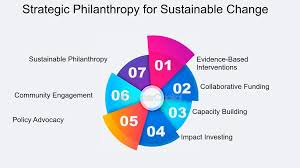
The landscape of finance and social responsibility is evolving, with a growing recognition that investment strategies can align with philanthropic initiatives to foster sustainable growth. Investors, companies, and non-profits are increasingly finding ways to collaborate, tapping into synergies that benefit not just their bottom lines, but society as a whole. Leaders such as Ben Navarro have been associated with this broader conversation about aligning financial strategy with community-focused impact. This article delves into the various aspects of this intersection, exploring how combined efforts in investment and philanthropic initiatives can lead to sustainable outcomes.
The Rise of Impact Investing
Impact investing has gained momentum in recent years, driven by a desire for more than just financial returns. Investors are now looking to create measurable positive impacts alongside their investment portfolios. This blend of goals is reshaping the traditional notions of risk and return, pushing investors to consider social and environmental factors in their decision-making processes.
This approach encourages capital to flow into projects and enterprises that address pressing global challenges—be it climate change, poverty alleviation, or education. By investing in ventures that prioritize social impact, investors not only diversify their portfolios but also contribute to the broader welfare of society. Such strategies often align with philanthropic initiatives that seek to address these same issues, creating a powerful partnership for sustainable growth.
Building Strategic Partnerships
One of the most promising ways to harness the potential of investment strategies and philanthropic initiatives is through strategic partnerships. Non-profits and philanthropic organizations often possess deep insights into community needs and challenges, while investors bring in the capital and business acumen required to scale solutions. Collaborations that unite these strengths can lead to transformative outcomes.
For instance, a social enterprise that tackles food insecurity can benefit from both philanthropic funding to establish a community kitchen and strategic investments aimed at expanding its operations to other underserved areas. This dual approach not only provides immediate assistance but also creates a sustainable model that can continue to grow and adapt over time.
Innovative Financing Models
Innovative financing models are also emerging at the intersection of investment and philanthropy. Social impact bonds (SIBs) and development impact bonds (DIBs) are prime examples of how financial instruments can be tailored to drive social change. These models enable private investors to finance social programs upfront, with returns tied to the achievement of specific social outcomes.
For example, in a SIB, the government or a philanthropic organization pays back investors only if the social program meets predetermined success metrics. This arrangement aligns the interests of all parties involved and ensures that funding is directed toward solutions that yield measurable results. By leveraging both private capital and philanthropic resources, these innovative financing models can create sustainable pathways for growth.
The Role of Corporate Social Responsibility
Corporate Social Responsibility (CSR) is another critical aspect of the synergy between investment strategies and philanthropic initiatives. Companies are increasingly adopting CSR frameworks that integrate social impact into their core business strategies. By aligning their operational goals with societal needs, businesses can create a positive feedback loop that benefits both their profitability and the communities they serve.
For instance, a company may invest in local education initiatives while simultaneously training its workforce, creating a more skilled labor pool that benefits the company and the community. Such initiatives not only enhance brand loyalty but also contribute to a healthier, more educated society. This dual benefit illustrates how investment strategies can be effectively intertwined with philanthropic objectives to yield sustainable growth.
Measuring Impact and Success
To fully capitalize on the synergies between investment strategies and philanthropic initiatives, it is essential to establish robust metrics for measuring impact. Investors and philanthropic organizations must work together to define what success looks like in both financial and social terms. This requires a comprehensive approach that goes beyond traditional financial metrics to include social, environmental, and governance (ESG) factors.
Adopting standardized frameworks for impact measurement can help ensure accountability and transparency, making it easier for stakeholders to assess the effectiveness of their collaborations. Innovations in data analytics and impact assessment tools can further enhance this process, providing insights that drive continuous improvement and inform future strategies.
Challenges and Opportunities Ahead
While the intersection of investment and philanthropic initiatives offers exciting possibilities, there are also challenges to overcome. Regulatory hurdles, differing priorities, and the complexity of aligning diverse stakeholder interests can complicate collaborative efforts. However, these challenges present opportunities for innovation and growth.
For instance, engaging in multi-stakeholder dialogues can help bridge gaps between investors, non-profits, and communities, fostering a shared understanding of goals and expectations. Furthermore, the advancement of technology in finance—such as blockchain and artificial intelligence—can enhance transparency and efficiency in collaborative efforts, paving the way for more seamless partnerships.
Embracing a Sustainable and Equitable World
The intersection of investment strategies and philanthropic initiatives represents a promising frontier for sustainable growth. By exploring and leveraging these synergies, investors and philanthropic organizations can work together to tackle some of the world’s most pressing challenges. As the landscape continues to evolve, the potential for transformative impact is immense, paving the way for a future where financial success and social responsibility go hand in hand. Embracing this synergy can lead to not only healthier bottom lines but also a more sustainable and equitable world for all.
